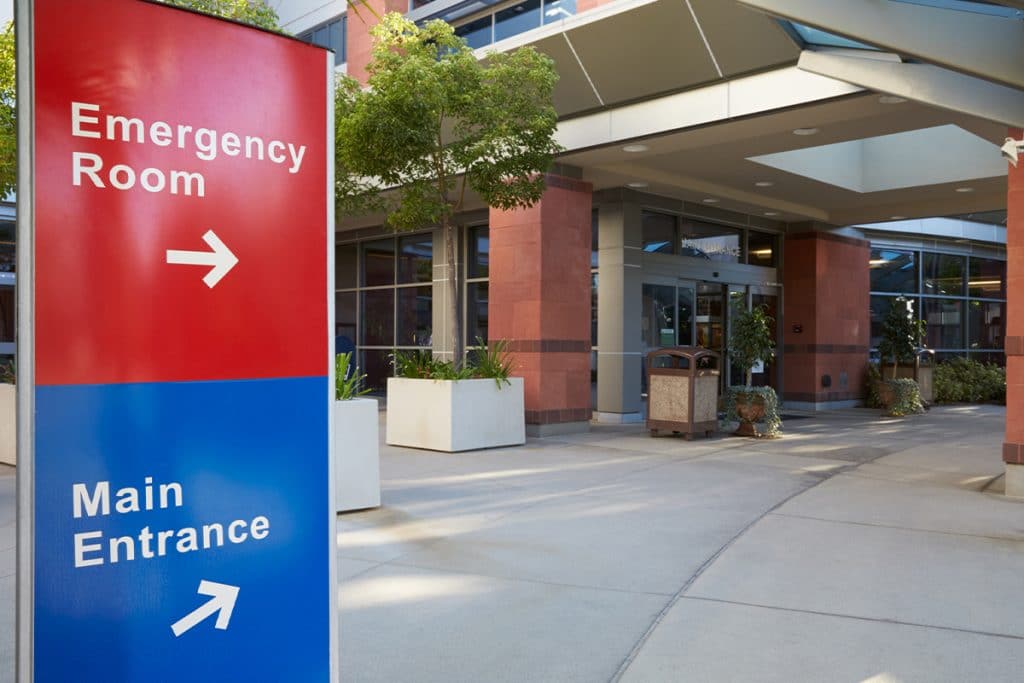On Tuesday, March 24, 2020, I was admitted to an (intentionally undisclosed) hospital’s Emergency Room for a ruptured appendix, which turned into a five-day, slightly horrific saga. This blog explores the up-close and personal experience I had with the current state of affairs of hospitals during this COVID-19 pandemic and emphasizes the importance of staying home. It is important to preface this blog with the fact that I am healthy now and that the lawyers at Ritter Spencer Cheng PLLC continue, from the safety of our respective homes, to advocate for our clients during these unprecedented times.
DAY 1: WHAT IS A PUI?
During the afternoon of Sunday, March 22, I began feeling feverish and having body aches. This continued for the next couple days with my body aches becoming worse and worse. I naturally started to fret that I may have COVID-19, but I did not show any other severe symptoms, such as a dry cough or shortness of breath. Finally, around 7:00 PM on Tuesday, March 24, after a long discussion regarding potential diagnoses with my brother, a soon-to-be Physician’s Assistant, I decided on my plan: drop the news on my roommate of my possible kidney infection or appendicitis and make a few jokes to ease him into the fact that he needs to take me to the ER right that second. Voila, I was hospital bound.
Upon my arrival to the hospital, I walked into the official COVID screening tent, a mandatory measure that patients must take before even entering the ER, where I was greeted by three nurses in full hazmat gear. They inquired about my symptoms, and I responded, “Well, I’ve had a high fever for…” One of the nurses immediately directed me to stick my arm out, attached a wristband, and instructed me to go to the waiting area of the tent. Another nurse gave me a mask, which much to my chagrin, I later came to realize I put on upside down. Two other people were sitting in this waiting area and one of them began dry coughing. “We’re six feet apart, right? How long can I hold my breath…an hour plus I hope?” I’m called into one of the approximate six individual rooms of the tent, panicked to explain all my symptoms as the frenzy was in full force. I had my blood work done and, for admittance purposes, had a video-call with the lady working at the front desk of the ER. Shortly after, I got escorted from the tent to the actual ER where everyone was wearing masks and various other protective gear.
Thankfully, I was placed in a room by myself. As I laid there awaiting what was next, I began hearing nurses and doctors walk or jog by asking, “Do we have a PUI,” (pronounced POO-EE). PUI…Patient Using…no. Patient Under Isolation…no. I did figure this ominous acronym must have been COVID-related.
When my doctor arrived, I explained my case in an anxious, blabbing fashion: “Well, I had a chest cold and congestion a couple weeks ago, I had a high fever starting on Sunday with aches in my back and lower front part of my body…” He nodded in understanding and took my temperature; 102.1 degrees. After an hour or so, I got wheeled into a different room for a CT scan, rolling through the maze of covered faces. When I arrived back to my room, I saw an individual who looked like he was in the movie The Hurt Locker write with a marker on my door: “PUI: Precautions.” A sinking feeling set in as I felt as if I had been marked, even though I was still unsure what this acronym meant.
My doctor returned and informed me that my appendix was perforated and there was a large abscess where the perforation occurred. I spewed out some nonsensical response, and even after receiving this bombshell of news, I didn’t manage to ask what a PUI was.
Another hour elapsed before the surgeon came in and explained that due to the abscess, I’d have to remain in the hospital for at least 3-5 days as they handle the severe infection with antibiotics and then I would be reassessed. Surgery on my appendix itself might not even be necessary if it is fully ruptured like an internal grenade blast. Well, damn…up to five days in the hospital during a pandemic, this was turning into a nightmare. Before the surgeon left, I did at least finally ask, “Doctor, what is a POO-EE, or, PUI?” He replied, “Oh, that’s ‘Patient Under Investigation’.” Yikes…1) that should not have taken me three or more hours to figure out; 2) I may have COVID-19.
Shortly thereafter, a nurse came in and informed me that she was going to be administering the COVID-19 nasal swab test. She told me that given my exceedingly high fever, recent sinus or chest infection, and overall body aches, this precautionary measure must be taken. Since I was already in agony, I requested the nurse to pump me with pain medication before undergoing this dreaded test. I heard the first chuckle/laugh of the entire night. However, even these extremely strong pain meds did not reduce the sheer discomfort of a musketeer-like swab being struck into the deepest cavities of my nasal passageway. “Oh no…the other nostril, too?” WAM and ouch. I was pleasantly surprised my brain remained intact afterwards though. The nurse stated, “You should get your test results within the next 6 hours to 3 days.” Since I was already confined to this new reality, this extraordinarily vague timeframe left me unphased.
Day 1 wrapped up with the news that the hospital implemented a full lockdown as of that day, meaning no visitors are allowed for any reason. I made various phone calls to family and friends, stewed in my general existential thoughts in isolation, and wondered what Day 2 would have in store.
DAY 2: DO I HAVE COVID-19?
After pulling an all-nighter due to the ruptured appendix pain and chaos of the entry rooms to the ER, I finally crashed for about an hour. However, my medically induced slumber was cut short by the patient in Z10, my next-door neighbor. Agonizing shouts reverberated throughout his and my room, so I shot up fully alert. Outside of my isolated room, approximately eight doctors and nurses in heavy duty protective gear attempted to tend to this PUI as he writhed and screamed in pain. Two doctors wheeled in a massive ventilator machine that looked like a Zamboni; the doctors and nurses were truly putting their lives at risk to help this man defeat this unforgiving virus.
As the patient in Z10 was tended to, two different patients had sheets thrown over their heads while they were in wheelchairs. These patients that were looking very ghost-like were rapidly escorted away from the main ER area. The entire atmosphere was alarming, confusing, and eerie.
I somehow managed to sleep a bit more during the day, but I was jolted awake by more mayhem in Z10. Small, portable ventilators were rushed into this patient’s room, doctors and nurses hurriedly went to work, and about five minutes later, I saw this man being transported on his bed with a sheet over his head and body, along with the attached, pumping ventilators. He was pushed by my room, which felt like a 10-minute, slow motion process. This surreal moment depicted the fight for this man’s life.
I didn’t even have time to collect myself as I saw a boy no older than 13-years-old getting pushed by in the same slow-motion manner. He did not have a sheet draped over him, but he was masked and quickly transported by four doctors and nurses. As all of these horrors occurred, I heard “Z11, let’s move Z11.” Moments later, two nurses came into my room, rapidly put my minimal belongings in a bag, had me sit in a wheelchair, and told me, “We have to put this sheet over your head as we escort you to your room….this is precautionary, but at least you’ll look like a ghost!” Whoosh, the sheet was tossed over my head and I was being pushed down the same hallway that the patient from Z10 and the young boy just went through. As I sat under my hood of darkness, zooming directions were being given out room after room; “Check his fever, I think it’s breaking”…”We gotta move this POO-EE!”…”Start pumping fluids immediately.” The commands rushed by as I was pushed down several hallways, undertaking the ultimate trust fall. We entered an elevator, and I was emitting hot fever breath into my mask while sweating profusely under the ghost sheet. After going up numerous floors, we finally arrived at our destination, my magically quiet and clean room. Hallelujah.
My new nurse introduced himself from outside the door of my room. He pulled his mask down and said, “It’s nice to put a face with the name, I’m Dave.” He had me do the same from inside my room. Dapper Nurse Dave then came in and gave me towels to wipe my sweat off and told me that after he leaves, it’ll be okay to remove the mask. Nurse Dave and I chatted about the chaos at the hospital and, with a sigh, he stated, “It’s just getting worse and worse…I don’t remember the last time someone hugged me.” Would if I could Nurse Dave, would if I could.
When Nurse Dave left, I immediately removed my mask and could breathe normally again for the first time in about 24 hours. A wave of tranquility rolled over me as I was at least out of the ER and in a quiet room. Nurse Dave came to my door and knocked happily, “Your COVID test came back negative!” I briefly basked in this relieving news, but I acknowledged that my immune system was in shambles. My fight of fending off this coronavirus had really just begun.
DAY 3: MAKE IT DRAIN
My stay in this peaceful room was short-lived. A bit after midnight and after about 45 minutes of sleep, my new nurse woke me up with the news that a change of instructions had been made: I’ll be going into surgery to have my abscess on my appendix drained.
Since I was “cleared” of COVID-19, no ghost sheet for this transport was needed, but the mask had to come back on. I got wheelchaired out of this wing and the elevator door opened; a nurse frantically told us to “back up, back up, back up…get a safe distance away!” I was wheeled down the hall away from the newly arrived nurse and patient and finally learned that I had been on the main COVID-19 quarantine floor of the hospital, where 20 or more nurses were tirelessly working – under normal circumstances, there are only six nurses working on this floor.
After arriving at a different wing of the hospital, I got set up in a new bed and went through my symptoms with yet another nurse, but it was more bearable this time around since she was cute and curious. She walked around the room with a bubbly personality, telling me how silly it was of me to wait so long to come in with a “ruptured appy.” She was doubtfully flirting with my two-days unshowered, scruffy, sickly self, but I still appreciated it nonetheless.
Cute Nurse Nancy gave me her takes on this coronavirus and why this hospital, like so many others, will be overwhelmed, but her jovial aura allowed for these dark and realistic conversations to flow with ease. She said she’d check in periodically, which at least gave me something to look forward to, especially since in-person human interactions are extraordinarily rare to come by these days.
We chatted some more during the 3 AM visit as a classic romance was clearly unfolding; her pouring out my urinals, providing me with damp towels to ease my fever, and pumping me with antibiotics and pain medications. Beat you to it Nicholas Sparks. When her shift ended around 7 AM, Cute Nurse Nancy departed my room but mentioned she’d be working the same 12-hour shift the next day. Fingers crossed.
I woke up around 9 AM and minutes later, I was transported to the radiology department for my operation. My fever spiked to about 101 degrees and I felt a stabbing pain where my infection was. That, compounded by the atmosphere I was currently in, put me in a gloomy mental state. I felt shameful for not appreciating life more and not being grateful for my generally good health. I anxiously desired for the surgery to go well but also to be able to remember this moment for when I need a sobering reflection to resort to in the future.
I signed the consent forms and the surgeon came by to inform me that I would not be going under; there would be no anesthesia, but I would be given several medications and numbing injections that would have similar effects. I’m told that basically every patient that had undergone this procedure did not remember it. I did not fit into that category.
I’ve decided to spare my readers the details, but long story short, I was alert and awake for all of the operation. The pain was not too bad, but I unfortunately was able to see the surgery occur in its entirety. To put it lightly, this was a dreadful experience. Thankfully, the operation was only about 30 minutes, but I will doubtfully ever forget it.
Out of curiosity I asked one of the nurses what would have happened had I not come to the hospital when I did. He told me that it was shocking I didn’t come in earlier and that if I waited another day or two, the infection inevitably would have spread to my bloodstream, thus making me go septic. Despite the surgery being a true nightmare, I am appreciative it happened and was a success…a century ago, I would have been a goner; so thank you modern medicine.
After arriving at my room post-surgery, my pain level eventually reached a 10 out of 10. The nurses helped ease my pain throughout the evening, but I was bedridden for the time being.
DAYS 4 AND 5: RECOVERY
Shockingly, I managed to have a good night of sleep post-surgery. I woke up and thought about how Cute Nurse Nancy didn’t end up having another shift here. Darn, so it was fleeting after all. See you never Cute Nurse Nancy. Actually, scratch that, I’ll retain hopes for my follow-up appointment, so stay tuned.
I rapidly recovered during Day 4 of my stay. I was able to somewhat walk on my own again and spent the rest of the day watching morbid pandemic news and resting. When I woke up Saturday morning, the doctors made their rounds and informed me that I checked their boxes for release; decent mobility, antibiotics and pain medications can be taken orally rather than intravenously, appetite is normalized, and ability to go to the bathroom by myself. I was stunned by this quick turnaround, and even though the pain was still agonizing, I decided I would much rather endure it at home than stay in the hospital any longer.
A few hours and lots of paperwork later, the transport team came to take me out of there. Since I came to the hospital with only the clothes I wore on Day 1 and no visitors were allowed, I had ditched that hazardous attire for a hospital gown and scrubs, all of which were slightly blood-spattered. They wheeled me down, and I saw that thing called the sun for the first time in what seemed like an eternity.
Thanks to the hard-working doctors, nurses, surgeons, and medical staff, I was able to write this blog from the comfort of my home. Although I tested negative for COVID-19, it was jarring to witness the war against the “Invisible Enemy.” All medical workers deserve the highest praise and the utmost respect in general, but especially during these tumultuous and dire times.
This blog was written by Paul Stevenson. Stay safe, follow the CDC guidelines, and adhere to the shelter-in-place orders. Contact Ritter Spencer Cheng or give us a call at 214.295.5074 for more information.







